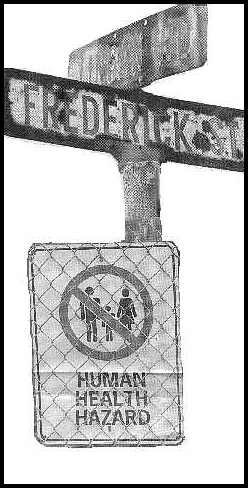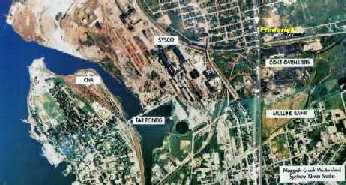 Nightmare on Frederick Street Continues ....
Nightmare on Frederick Street Continues ....
For Immediate Release
February 17, 1999
*****************************************************************
The Sierra Club of Canada requested that Dr. Rosalie Bertell and Roger
Dixon of the International Institute of Concern for Public Health (IICPH)
prepare a response to the media release issued by CANTOX Inc.
What follows is the response from the IICPH. However, both the IICPH and
the Sierra Club of Canada, are more than willing to have an open debate on
CANTOX Inc.'s findings, with CANTOX Inc. and the N.S. Medical Officer Jeff
Scott, at anytime and in any media format.
******************************************************************
IICPH Responds To CANTOX
CANTOX PRESS RELEASE: Cantox rejects the conclusion of the IICPH review
on the Frederick Street Risk Assessment, and we stand by the findings of
the Frederick Street Assessment and the interpretation presented in our
report of August, 1998. We disagree with the IICPH statement that the
methodologies applied by Cantox are "inadequate and insufficient". We
followed internationally accepted methods designed to assess contaminated
sites.
IICPH RESPONSE: CANTOX APPEARS TO BE USING A METHODOLOGY DESIGNED
TO
DETERMINE LIABILITY RATHER THAN HUMAN HEALTH HAZARD. THIS IS OBVIOUS IN
THEIR ELIMINATION OF PAST EXPOSURES FROM THE SITE AND THE POTENTIALLY
CUMULATIVE HEALTH DAMAGE FROM PAST ACTIVITIES. MOREOVER, THEIR CONSTANT
APPEAL TO "BACKGROUND" EXPOSURES HAS TO DO WITH LIABILITY RATHER THAN
HEALTH HARM. BACKGROUND MAY NOT BE HARMLESS. IT APPEARS TO BE USED TO SHOW
THAT THE SITE, ALTHOUGH IT MAY BE HARMFUL, MAY ALSO BE LIKE OTHERS IN
CANADA. THIS IS IRREVELANT WHEN DETERMINING LOCAL HEALTH DAMAGE BUT
IMPORTANT IF THE FOCUS IS LIABILITY.
CANTOX PRESS RELEASE: Cantox scientists are experts in the methodologies
used in risk assessments. We are the largest 4risk assessment firm in
Canada, and we have conducted these types of assessments longer than any
other firm in Canada. Over the past decade we have conducted several
hundred large-scale detailed quantitative risk assessments of potential
risks to human health and ecological receptors from exposures to chemicals
from a variety of sources. We have evaluated some of the largest and most
contaminated properties in Canada ( such as the former U.S. Naval base in
Argentia, Newfoundland), and we are widely recognized as leaders in this
field.
IICPH RESPONSE: PLEASE PROVIDE A LIST OF THE CONTAMINATED SITE
WHICH
WERE ASSESSED BY CANTOX, AND THE RECOMMENDATIONS WHICH CANTOX MADE FOR
EACH. WAS ANY SITE FOUND TO BE A HUMAN HEALTH HAZARD?
CANTOX PRESS RELEASE: The IICPH review is not a "peer review" of the
Frederick Street assessment, because this group is not recognized in the
field of risk assessment. As such, many of the comments made result from a
lack of understanding of the science of risk assessment and toxicology.
IICPH RESPONSE: DR. BERTELL HAS A PH.D. IN MATHEMATICS, WITH A
SPECIALTY IN PROBABILITY AND MEASURE THEORY. THIS IS PRECISELY THE
DISCIPLINE REQUIRED TO HANDLE RISK ASSESSMENT. ROGER DIXON HAS AN M.P.H
DEGREE AS WELL AS ACCREDITATION IN INDUSTRIAL HYGIENE. THIS IS EQUIVALENT
TO TOXICOLOGY FOR EVALUATING THIS SITE ASSESSMENT. DR. BERTELL HAS THIRTY
YEARS EXPERIENCE WITH BIOMEDICAL/POLLUTION PROBLEMS AND HAS BEEN RECOGNIZED
WITH NUMEROUS NATIONAL AND INTERNATIONAL AWARDS AND HONORARY DEGREES FOR
HER WORK. ROGER DIXON HAS HAD EXTENSIVE EXPERIENCE OVER TWENTY THREE
YEARS. HE HAS BEEN EMPLOYED BY HEALTH CANADA, ENVIRONMENT CANADA, THE
GOVERNMENTS OF ONTARIO AND ALBERTA, AS WELL AS MANY OTHER AGENCIES. ROGER
IS ALSO AN ENGINEER WITH EXTENSIVE EXPERIENCE IN HAZARDOUS PROCESS
OPERATIONS, INCLUDING COKE OVENS. ROGER DID THE FIRST STUDY IN ONTARIO ON
COKE OVEN WORKER EXPOSURES.
CANTOX PRESS RELEASE: We disagree with IICPH statement that there were
insufficient data to draw conclusions. Cantox was asked to conduct a study
using existing information. It is our professional opinion that the data
available at the time of the assessment were adequate to provide a
preliminary indication of potential health risks associated with current
chemical concentration on Frederick Street, and area. The assessment
considered and clearly stated the data limitations in the overall
interpretation of potential risks. In light of these limitations, several
recommendations were made in the Frederic Street assessment report related
tot he need for further collection of data. We expect that these
recommendations will be followed through on, as we view them as being very
important.
IICPH RESPONSE: THE DATA LIMITATIONS AND PRELIMINARY NATURE OF THE
RECOMMENDATIONS WERE NOT ADEQUATELY REFLECTED IN THE STRONG ASSURANCES
WHICH CANTOX GAVE TO THE PUBLIC THAT THERE WAS NO RISK TO THEIR HEALTH.
CANTOX PRESS RELEASE: The IICPH report criticises the amount of time
spent on the assessment. We had 17 scientific staff working on the project
for a total of approximately 600 hours, which is equal to about 75 person
days of time.
IICPH RESPONSE: THE REPORT DOES NOT REFLECT THAT LEVEL OF
COMMITMENT
TO THE WORK.
CANTOX PRESS RELEASE: The IICPH report ignores the fact that Cantox made
a series of very important recommendations in the risk assessment report,
which we feel are critical to further the understanding of the coke ovens
site and its potential impact on nearby residents.
IICPH RESPONSE: CANTOX FAILED TO GIVE CAUTIONS THE PRODOMINANT
PLACE
WHICH THEY DESERVE IN ITS REPORT. THE GENERAL PUBLIC PERCEPTION AND
OFFICIAL INTERPRETATION OF THE REPORT IS THAT THE SITE DOES NOT NOT POSE
ANY "SHORT TERM" THREAT TO HUMAN HEALTH. MOST IMPORTANT TERMS IN THE
REPORT REMAIN UNDEFINED. FOR EXAMPLE, RISK OF WHAT?, HOW LONG IS "SHORT
TERM", WHY SHOULD THE PUBLIC NOT BE CONCERNED FOR THE "LONG TERM"?
CANTOX PRESS RELEASE: The IICPH report ignores the fact that the
assessment conducted by Cantox was highly conservative, or protective of
health. For example, we assumed that people lived on Frederick Street for
70 years, never leaving the site except for a 2 week vacation one time a
year. This means that we assumed that no one left the area, even to go to
work or to do errands such as grocery shopping over a 70 year period. The
IICPH ignores the blood and hair analysis for lead and arsenic, which was
conducted on almost all residents. These data are critical to the
conclusions of the Cantox report, and clearly indicate that exposure of the
residents to arsenic and lead are not elevated, and are the same as any
normal, healthy population elsewhere in the world.
IICPH RESPONSE: CANTOX ASSUMED THAT THE 70 YEARS OF RESIDENCE WERE
ALL EXACTLY LIKE THE "STUDY" YEAR. IT TOOK NO NOTICE OF THE ACTUAL
CONDITIONS OF THE SITE OVER THE PAST OR THE RISK POSED BY FUTURE CLEANUP
ACTIVITIES AT THE SITE.
CANTOX PRESS RELEASE: The IICPH report criticizes the way Cantox has
applied soil quality guidelines and /or criteria, and they imply that we
have no understanding of these values. We are recognized experts in
developing soil quality guidelines and we were not "confused" about how
they should be applied. The "blanket statement" made by the IICPH that
soil quality guidelines established in 1997 cannot be regarded as
protective of human health is completely incorrect, and clearly indicates
their lack of understanding on how these values are derived.
IICPH RESPONSE: IF CANTOX IS FULLY CONSCIOUS OF THE DERIVATION OF
SOIL GUIDELINES THEN THEY SHOULD EVEN BE MORE CONFUSED FOR SUCH STATEMENTS
AS: "IF THE EXPOSURES ARE BELOW THE GUIDELINES, THEN WE KNOW THAT THERE IS
NO HARM TO HUMAN HEALTH".
CANTOX PRESS RELEASE: The IICPH reports suggests that we neglected to
evaluate certain chemicals, or that certain important data were missing.
We reviewed each of these instances carefully, these suggestions are
unfounded.
IICPH RESPONSE: WE WERE SPECIFIC ON THESE CLAIMS. A GENERAL
SELF-EXONORATION IS UNACCEPTABLE.
CANTOX PRESS RELEASE: The IICPH report makes several incorrect
statements. Two examples of errors are as follows: The IICPH report is
incorrect in stating that there were only 4 backyard soil samples analysed.
There were 7.
IICPH RESPONSE: THIS IS ALSO AN INADEQUATE SAMPLE.
CANTOX PRESS RELEASE: The IICPH states that no soil samples were
analysed for Polycyclic Aromatic Hydrocarbons(PAH'S). In fact, several
soil samples were analysed for these compounds.
IICPH RESPONSE: CANTOX SHOULD PRESENT THE RESULTS OF SUCH ANALYSIS
IF
THEY EXIST.
CANTOX PRESS RELEASE: Cantox stands by the findings of the Frederick
Street Assessment and the interpretation presented in our report of August,
1998. Cantox is a science based consulting firm specializing in providing
expert advice to a wide range of clients on toxicology issues related to
human health, the environment and regulatory affairs. There are over 50
highly qualified professionals with expertise in diverse areas of human and
aquatic toxicology, environmental fate and modelling, human health and
environmental risk assessment and risk communication. Cantox scientists
are knowledgeable, and experienced in the methodologies use in risk
assessments. Cantox has provided expert advice to numerous international
committees and organizations including the World Health Organization, FEMA,
the International Agency for Research on Cancer, the U.S. National Academy
of Sciences, the U.S. National Toxicology Program, and the Natural Sciences
and Engineering Research Council.
IICPH RESPONSE: COULD CANTOX PLEASE SUBMIT A STATEMENT FROM ONE OF
ITS TOXICOLOGISTS (UNDER HIS OR HER OWN NAME) OFFERING AN OPINION ON THE
HEALTH HAZARDS WHICH HAVE BEEN EXPERIENCED BY THE FREDERICK STREET
RESIDENTS IN THE PAST AND THOSE WHICH CAN BE EXPECTED DURING A CLEAN UP
OPERATION.
For further information call:
INTERNATIONAL INSTITUTE of CONCERN for PUBLIC HEALTH (IICPH)
Rosalie Bertell, Ph. D., GNSH
President, ACS (1998-2000), President IICPH (1984+)
710-264 Queens Quay West, Toronto ON M5J 1B5 CANADA
Tel: 1-416-260-0575,
Fax: 1-416-260-3404,
Email: IICPH@compuserv.com
CANTOX Inc.
Christine Moore, Vice-President - Eastern Region
Cantox Environmental Inc., Telephone: 902-429-0278
Sierra Club of Canada
Elizabeth May, Executive Director, Sierra Club of Canada
1.613.241.4611
Bradford Duplisea, Toxics Coordinator
Sierra Club of Canada
1.613.241.4611
****************************************************
 JAG meets with Pier Residents
JAG meets with Pier Residents
 Return to Sierra Club Home Page
Return to Sierra Club Home Page
 Nightmare on Frederick Street Continues ....
Nightmare on Frederick Street Continues .... JAG meets with Pier Residents
JAG meets with Pier Residents Return to Sierra Club Home Page
Return to Sierra Club Home Page